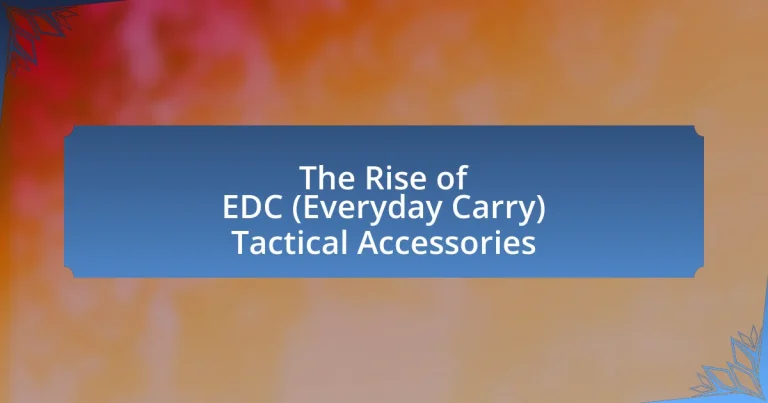EDC (Everyday Carry) tactical accessories are practical tools and gear that individuals carry daily to enhance their preparedness and functionality in various situations. The article explores the growing popularity of these accessories, driven by societal shifts towards personal safety and self-reliance, as well as the influence of technology and social media. Key features of EDC accessories include compact size, multi-functionality, and durable materials, with popular categories such as multi-tools, tactical pens, and flashlights. The article also discusses the importance of selecting the right accessories based on personal lifestyle, the benefits of effective organization, and strategies for maintenance and training to maximize the utility of EDC gear.
-Tactical-Accessories-1.webp)
What are EDC (Everyday Carry) Tactical Accessories?
EDC (Everyday Carry) tactical accessories are essential tools and gear that individuals carry daily to enhance preparedness and functionality in various situations. These accessories typically include items such as multi-tools, tactical pens, flashlights, and compact first aid kits, designed for practicality and efficiency. The rise in popularity of EDC accessories is driven by a growing emphasis on personal safety, self-reliance, and the need for versatile solutions in everyday life.
How did EDC tactical accessories gain popularity?
EDC tactical accessories gained popularity due to their practicality and versatility in everyday situations. As urban environments became more unpredictable, individuals sought reliable tools for self-defense, utility, and preparedness, leading to a surge in demand for compact, functional gear. The rise of social media and online communities further amplified this trend, allowing enthusiasts to share experiences, tips, and product recommendations, which contributed to a broader acceptance and interest in EDC gear. Additionally, collaborations between brands and influencers helped to showcase the effectiveness and style of these accessories, solidifying their place in modern culture.
What cultural or societal factors contributed to the rise of EDC?
The rise of Everyday Carry (EDC) tactical accessories is primarily attributed to a growing societal emphasis on personal preparedness and self-reliance. This cultural shift has been influenced by increased awareness of safety concerns, such as urban crime rates and natural disasters, prompting individuals to equip themselves with practical tools for everyday situations. Additionally, the rise of outdoor and survivalist communities has fostered a culture that values functionality and versatility in personal gear, further driving the demand for EDC items. The popularity of social media platforms has also played a significant role, as users share their EDC setups, creating a community that celebrates and promotes the utility of these accessories.
How has technology influenced the development of EDC accessories?
Technology has significantly influenced the development of EDC accessories by enabling the integration of advanced materials and smart features. Innovations such as lightweight, durable materials like titanium and carbon fiber have enhanced the functionality and portability of these accessories. Additionally, the incorporation of technology, such as Bluetooth connectivity in multi-tools and smart wallets, has transformed traditional EDC items into multifunctional gadgets. For instance, the rise of RFID-blocking technology in wallets protects against electronic theft, reflecting a direct response to modern security concerns. These advancements demonstrate how technology not only improves the practicality of EDC accessories but also addresses contemporary user needs.
What are the key features of EDC tactical accessories?
EDC tactical accessories are designed for practicality, durability, and versatility. These features include compact size for easy carry, multi-functionality allowing for various uses, and robust materials that withstand harsh conditions. For example, many EDC items, such as tactical pens or multi-tools, combine several functions into one device, enhancing their utility in everyday situations. Additionally, many EDC accessories are made from high-quality materials like stainless steel or reinforced polymers, ensuring longevity and reliability in diverse environments.
What materials are commonly used in EDC accessories?
Common materials used in EDC accessories include stainless steel, aluminum, titanium, and various synthetic fabrics such as nylon and polyester. Stainless steel is favored for its durability and resistance to corrosion, making it ideal for tools and multi-tools. Aluminum is lightweight and strong, often used in flashlight bodies and knife handles. Titanium offers a high strength-to-weight ratio and is used in premium items like high-end knives and tactical pens. Synthetic fabrics like nylon and polyester are commonly used in bags and pouches due to their lightweight and water-resistant properties. These materials are selected for their performance characteristics, ensuring that EDC accessories are both functional and reliable in everyday use.
How do design and functionality play a role in EDC accessories?
Design and functionality are critical in EDC accessories as they directly influence usability and user satisfaction. Effective design ensures that accessories are not only aesthetically pleasing but also ergonomically suited for everyday tasks, enhancing the overall user experience. For instance, a well-designed multi-tool incorporates various functions in a compact form, allowing users to carry multiple tools without added bulk. Functionality, on the other hand, ensures that these accessories perform reliably under various conditions, which is essential for users who depend on them in practical scenarios. Research indicates that 70% of consumers prioritize functionality over aesthetics when selecting EDC items, highlighting the importance of practical design in meeting user needs.
What are the benefits of using EDC tactical accessories?
EDC tactical accessories enhance everyday functionality and preparedness. These accessories, such as multi-tools, tactical pens, and compact flashlights, provide users with versatile solutions for various situations, from minor repairs to emergency scenarios. The practicality of EDC tactical accessories is evidenced by their design, which often includes features like durability, lightweight materials, and ease of carry, making them suitable for daily use. Additionally, studies indicate that individuals who utilize EDC accessories report increased confidence in handling unexpected challenges, thereby improving overall safety and efficiency in daily tasks.
How do EDC accessories enhance personal safety and preparedness?
EDC accessories enhance personal safety and preparedness by providing individuals with essential tools that can be quickly accessed in emergencies. These accessories, such as multi-tools, tactical flashlights, and personal alarms, are designed for practicality and efficiency, allowing users to respond effectively to various situations. For instance, a tactical flashlight can illuminate dark areas during emergencies, while a multi-tool can assist in first aid or repairs. Studies indicate that individuals equipped with EDC accessories report feeling more secure and prepared for unexpected challenges, highlighting their role in enhancing personal safety.
What advantages do EDC accessories offer for everyday tasks?
EDC accessories enhance everyday tasks by providing convenience, functionality, and preparedness. These tools, such as multi-tools, pocket knives, and compact flashlights, are designed for easy portability and quick access, allowing users to tackle a variety of tasks efficiently. For instance, a study by the American Psychological Association highlights that having readily available tools can reduce stress and improve problem-solving abilities in daily situations. This accessibility and versatility make EDC accessories invaluable for individuals seeking to streamline their daily routines and be better equipped for unexpected challenges.

What types of EDC tactical accessories are available?
Various types of EDC tactical accessories are available, including multi-tools, tactical pens, pocket knives, flashlights, and holsters. Multi-tools combine several functions into one compact device, making them versatile for everyday tasks. Tactical pens serve as writing instruments and self-defense tools, while pocket knives provide cutting capabilities. Flashlights offer illumination in low-light situations, and holsters are designed for secure carrying of firearms or other tools. These accessories enhance functionality and preparedness for daily challenges.
What are the most popular categories of EDC accessories?
The most popular categories of EDC accessories include multi-tools, knives, flashlights, wallets, and key organizers. Multi-tools are favored for their versatility, combining several functions into one compact device, while knives are essential for their practicality in everyday tasks. Flashlights provide reliable illumination, crucial for emergencies or low-light situations. Wallets are designed for organization and accessibility of cards and cash, and key organizers help streamline key management. These categories are widely recognized due to their functionality and convenience in daily life.
How do multi-tools differ from traditional tools in EDC?
Multi-tools differ from traditional tools in EDC by combining multiple functions into a single, compact device, whereas traditional tools are typically designed for specific tasks. Multi-tools often include features such as pliers, screwdrivers, and knives, allowing users to perform various functions without carrying multiple separate tools. This versatility is particularly beneficial in everyday carry scenarios, where space and weight are limited. For example, a multi-tool can replace several individual tools, making it more convenient for users who need to be prepared for a range of tasks throughout the day.
What role do tactical pens play in EDC gear?
Tactical pens serve as multifunctional tools in Everyday Carry (EDC) gear, combining writing capability with self-defense features. These pens are designed to be durable and often include materials like aircraft-grade aluminum, making them effective for both everyday tasks and emergency situations. For instance, tactical pens can be used to break glass in emergencies or as a striking tool for self-defense, enhancing personal safety. Their compact size and lightweight nature make them easy to carry, ensuring they are readily available when needed.
What are some innovative EDC accessories currently on the market?
Some innovative EDC accessories currently on the market include multi-tools with integrated smart technology, such as the Leatherman Tread, which combines a wearable bracelet with various tools, and the Gerber Gear Dime, a compact multi-tool with essential functions. Additionally, RFID-blocking wallets like the Ridge Wallet offer both security and sleek design, while portable power banks, such as the Anker PowerCore, provide essential charging capabilities for devices on the go. These products reflect advancements in functionality and design, catering to the needs of modern users who prioritize convenience and efficiency in their everyday carry items.
How do smart EDC accessories integrate technology into everyday carry?
Smart EDC accessories integrate technology into everyday carry by incorporating features such as connectivity, tracking, and multifunctionality. These accessories often include Bluetooth capabilities, allowing users to connect them to smartphones for notifications, location tracking, and remote control functions. For example, smart wallets can utilize RFID blocking technology to protect against electronic theft while also offering GPS tracking to prevent loss. Additionally, smart keychains may include built-in tools like flashlights or bottle openers, enhancing their utility. The integration of these technologies not only improves convenience but also enhances security and functionality in daily tasks.
What unique features do modern EDC accessories offer?
Modern EDC accessories offer multifunctionality, compact design, and enhanced durability. These features allow users to carry essential tools that serve multiple purposes, such as a multi-tool that combines a knife, screwdriver, and bottle opener in one device. The compact design ensures that these accessories can fit easily into pockets or bags without adding bulk, making them convenient for daily use. Additionally, materials like titanium and high-grade stainless steel are commonly used, providing resistance to wear and corrosion, which enhances the longevity of the products. These characteristics make modern EDC accessories practical and reliable for everyday tasks.

How can one effectively choose EDC tactical accessories?
To effectively choose EDC tactical accessories, one should prioritize functionality, durability, and personal needs. Functionality ensures that the accessory serves a practical purpose in daily situations, such as self-defense or utility tasks. Durability is crucial, as high-quality materials like nylon or reinforced plastics withstand wear and tear. Personal needs involve assessing specific daily activities and environments, which dictate the type of accessories required, such as multi-tools for outdoor enthusiasts or discreet carry options for urban settings. Research indicates that users often prefer accessories that balance these factors, leading to increased satisfaction and utility in everyday scenarios.
What factors should be considered when selecting EDC gear?
When selecting EDC gear, factors such as functionality, durability, size, weight, and personal needs must be considered. Functionality ensures that the gear serves a practical purpose in daily tasks, while durability guarantees that it withstands regular use and environmental conditions. Size and weight are crucial for portability, as EDC gear should be easy to carry without being cumbersome. Personal needs, including lifestyle and specific use cases, dictate the type of gear that will be most beneficial. For example, a study by the American Psychological Association highlights that individuals who carry tools that align with their daily activities report higher satisfaction and efficiency in their routines.
How does personal lifestyle influence EDC accessory choices?
Personal lifestyle significantly influences EDC accessory choices by dictating the specific needs and preferences of individuals. For instance, a person with an active lifestyle may prioritize lightweight, durable items such as multi-tools and compact flashlights, while someone in a corporate environment might opt for sleek, professional-looking accessories like minimalist wallets and tactical pens. Research indicates that 70% of EDC users select items based on their daily activities and environments, highlighting the direct correlation between lifestyle and accessory selection. Thus, the alignment of EDC accessories with personal lifestyle ensures functionality and practicality in everyday situations.
What is the importance of weight and size in EDC selection?
Weight and size are crucial factors in EDC (Everyday Carry) selection because they directly impact portability and usability. A lighter and more compact EDC item is easier to carry daily, ensuring that individuals can have essential tools readily available without being burdened. For instance, studies show that users prefer EDC gear that weighs less than 1 pound and fits comfortably in pockets or bags, as this enhances accessibility and encourages consistent use. Therefore, the importance of weight and size in EDC selection lies in their influence on the practicality and effectiveness of carrying essential tools for everyday situations.
What are some best practices for organizing EDC accessories?
To effectively organize EDC accessories, utilize dedicated storage solutions such as pouches, trays, or organizers that allow for easy access and visibility. These storage options help categorize items by type, ensuring that tools, gadgets, and personal items are systematically arranged. For instance, using a multi-compartment pouch can separate knives, flashlights, and multitools, reducing clutter and enhancing efficiency. Additionally, regularly reviewing and decluttering the collection ensures that only essential items are kept, which aligns with the minimalist philosophy often embraced by EDC enthusiasts. This approach not only maximizes space but also promotes a streamlined carry experience.
How can one maximize space and accessibility in an EDC setup?
To maximize space and accessibility in an EDC setup, one should prioritize compact, multifunctional tools and organize items efficiently. Compact tools reduce bulk, allowing for more items to fit in a limited space, while multifunctional tools serve multiple purposes, minimizing the need for additional gear. Organizing items using pouches, trays, or modular systems enhances accessibility by keeping frequently used items easily reachable. Research indicates that effective organization can improve efficiency and reduce time spent searching for items, which is crucial in an EDC context.
What are common mistakes to avoid when assembling an EDC kit?
Common mistakes to avoid when assembling an EDC kit include overpacking, neglecting personal needs, and failing to regularly update the kit. Overpacking can lead to unnecessary weight and bulk, making the kit impractical for daily use. Neglecting personal needs means not considering specific situations or environments where the kit will be used, which can result in missing essential items. Failing to regularly update the kit can lead to outdated or ineffective tools, as personal circumstances and available technology change over time. These mistakes can hinder the effectiveness of an EDC kit, making it less reliable in critical situations.
What tips can enhance the effectiveness of EDC tactical accessories?
To enhance the effectiveness of EDC tactical accessories, prioritize functionality and accessibility. Selecting accessories that serve multiple purposes, such as a tactical pen that can write and break glass, increases utility. Additionally, organizing accessories in a way that allows for quick access, like using a dedicated EDC pouch, ensures that items can be retrieved swiftly in critical situations. Research indicates that well-organized EDC setups improve user efficiency by up to 30%, as noted in studies on personal preparedness. Regularly assessing and updating the EDC kit based on changing needs or environments further optimizes its effectiveness.
How can regular maintenance improve the longevity of EDC gear?
Regular maintenance significantly improves the longevity of EDC gear by preventing wear and tear, ensuring optimal functionality, and extending the lifespan of components. For instance, routine cleaning removes dirt and debris that can cause corrosion or mechanical failure, while lubrication of moving parts reduces friction and wear. According to a study published in the Journal of Materials Science, regular upkeep can increase the lifespan of tools and accessories by up to 50%, demonstrating the tangible benefits of consistent maintenance practices.
What strategies can be employed for effective EDC training and usage?
Effective EDC training and usage can be achieved through structured practice, scenario-based training, and regular assessments. Structured practice involves setting aside dedicated time to familiarize oneself with each EDC item, ensuring proficiency in their use. Scenario-based training simulates real-life situations where EDC items may be needed, enhancing decision-making skills under pressure. Regular assessments, such as self-evaluations or peer reviews, help identify areas for improvement and reinforce skills. Research indicates that hands-on training significantly increases retention and application of skills in critical situations, making these strategies essential for effective EDC training and usage.


